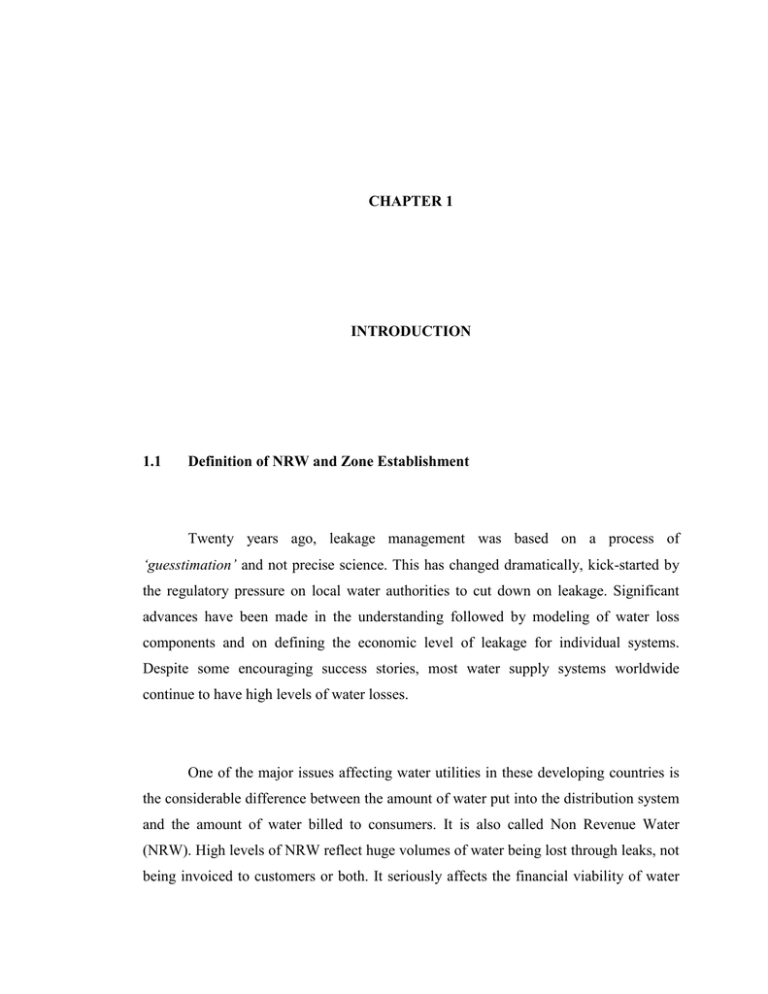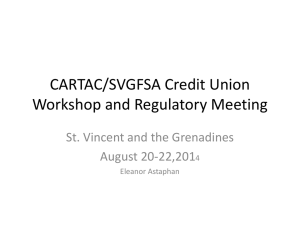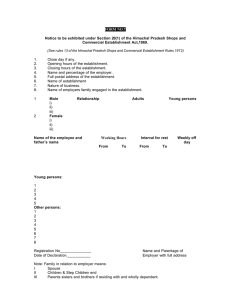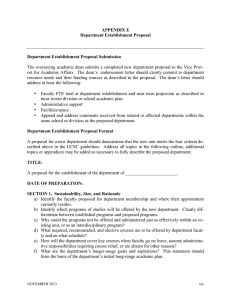CHAPTER 1 INTRODUCTION 1.1 Definition of NRW and Zone Establishment
advertisement

CHAPTER 1 INTRODUCTION 1.1 Definition of NRW and Zone Establishment Twenty years ago, leakage management was based on a process of ‘guesstimation’ and not precise science. This has changed dramatically, kick-started by the regulatory pressure on local water authorities to cut down on leakage. Significant advances have been made in the understanding followed by modeling of water loss components and on defining the economic level of leakage for individual systems. Despite some encouraging success stories, most water supply systems worldwide continue to have high levels of water losses. One of the major issues affecting water utilities in these developing countries is the considerable difference between the amount of water put into the distribution system and the amount of water billed to consumers. It is also called Non Revenue Water (NRW). High levels of NRW reflect huge volumes of water being lost through leaks, not being invoiced to customers or both. It seriously affects the financial viability of water 2 utilities through lost revenues and increased operational costs. A high NRW level is normally a surrogate for a poorly run water utility that lacks the governance, autonomy, accountability, technical and managerial skills which are necessary to provide reliable service to their population. District Meter Zoning (DMZ) is a technique used in reducing NRW water level in most of the developing countries. This technique is becoming more prevalent with the increasingly urgent necessity to better manage water networks and to reduce the relatively high levels on NRW. Although the majority of these District Meter Zoning projects are proven to be successful in the short term, unfortunately some are perceived as less than successful in the long term due to a lack of District Meter Zoning continuity and sustainability. Zone Establishment (ZE) is a process in this DMZ technique. The basic principle for this process is to install a Bulk Meter and Pressure Reducing Valve (PRV) at a strategic point in the distribution system. Each meter records the flow into the discrete zone that has been set up with a defined and permanent boundary. This enables night flows into the zone to be regularly monitored for calculation of leakage level. Previously unreported leaks are then identified, accurately located and repaired. The water pressure in each zone is also controlled trough the PRV that has been fixed. By this way, background and future leakage could be minimized. 3 1.2 Background of Study The key to developing a strategy for management of non-revenue water (NRW) is to gain a better understanding of the reasons for NRW and the factors which influence its components. Techniques and procedures can be developed and tailored to the specific characteristic of the network and local influencing factor. This is to tackle each of the components in a prioritized manner. This diagnostic approach, followed by the practical implementation of solutions which are practicable and achievable can be applied to any water company located in any part of the world to develop a strategy for NRW management. Non-revenue water is the difference between water produced and water sold. The level of NRW has reached unacceptable levels in the majority of water utilities all around the world. Outsourcing of NRW reduction activities is often the only feasible solution. In the year 2000, the world largest NRW reduction contract at that time was the Selangor NRW reduction project. The estimated cost for the whole project was RM 398 Million . Phase 1 project for non-revenue water in Syabas was done by Premier Ayer Sdn Bhd. Phase 2 is a continuous project works from phase 1.The second phase was awarded to Jalur Cahaya Sdn Bhd which is a new face in water industry around klang valley. Duration for phase 2 project is from Mac 2006 to April 2009 with a contract value of RM 163 Million. The contract will be extended by the client depending on the performance of the company during the existing contract period. The job scope of this project is to maintain the existing 222 zones that had been setup during phase 1 project. Besides the maintenance work, the main task of this project is to setup new additional zones and achieve the targeted water savings during the project period. Setting up new zones is also called Zone Establishment. Zones here mean dividing the distribution system into small discrete sectors so that the leakage and pressure management can be done effectively. 4 There are few stages involved in zone establishment process before a zone could be setup completely and verified as a successful zone by the client. This zone will be maintained all the time during the contract period. Delay occurs during the process of zone establishment that makes the entire organization to be unorganized, last minute work preparation and drop in quality of work. Project delays cause the client to be unhappy with the contractor involved. 1.3 Justification of Study Zone Establishment is the main scope of work to be done for the NRW Project in Selangor. The delay that occurs during the process of Zone Establishment makes the target of the project more complicated and difficult to be achieved. This study is being done to identify the delays and problems that cause these delays. This identification can be very useful to improve the zone establishment process by making it more efficient and systematic to produce a high quality outcome. A new improved Zone Establishment work process will be recommended at the end of the study. The study can also give a helping hand to the organization to extend its current contract period to a longer duration as zone establishment work process is a main job scope of the project. 5 1.4 Aim and Objectives This study has targeted three objectives to achieve at the end of the study period. The objectives are: 1. To identify the delay that occurs in current Zone Establishment Work Process. 2. To identify the factors that causes the delay in current Zone Establishment Work Process. 3. To propose new strategies to improved Zone Establishment Work Process. These three objectives are the specific goals that undertake the responsibilities to achieve the aim of the study. The main aim of this study is to improve the current zone establishment work process so that delay can be minimized. 1.5 Scope of Study Five zones that are going to be established during the study period will be selected and focused. The first process or activity will be the trial hole work. The purpose of this work is to identify the pipe size, overall site condition including the underground cabling services and to gather all other related information. The final activity in Zone Establishment process will be the handing over the zone to the Monitoring and Maintenance Team (M&M) and preparing a white folder file. M&M team will take after the over the zone and maintain it over the contract period. White folder that has been prepared will be submitted to the client for zone recognition. This 6 white folder would contain all detailed information of that particular zone including the maps, test results and all other important documents. The focus will be on the duration of all activity involved in Zone Establishment work process. The duration from the activity for all five zones will be compared with the targeted duration set by the organization. If there is a very obvious delay in most of the zones, study will be done to identify the problems that cause the delay. This includes discussions with the head of department or person responsible who causes the delay. 7 Trial Hole: Construction Team Location Not Suitable, Compile all information from trial hole and draft site condition drawing: Region Construction Team Trial Hole Different Location Amend Discuss with ZE team and Regional Manager on location detail: Region Construction Team Headquarters Construction Team to design and prepare drawing: HQ Construction Team If Needed Drawing checked and verify by Regional Manager: Regional Manager Submit drawing with cover letter to Syabas for approval to shutdown supply (14days) and a copy to Contract Procurement Department (CPD) for selection of contractor: ZE Team CPD invite contractor to submit their quotation for the works according to drawing: CPD CPD select Contractor: CPD Meter Installation and Chamber Construction by contractor: Region Construction Team All necessary test, settings, leak repairs done: ZE Team and Region Construction Team Prepare White Folder to submit to Client (Syabas) and Handing over the zone to M&M team: ZE Team Zone Establishment work process completed. Figure 1.1: Scope of Work 8 1.6 Research Methodology This study will be done by identifying the duration taken by each activity from the overall Zone Establishment Work Process. The duration taken will be compared with the standard time duration set by the organization. If there is a common delay at the same activity for most of the zones, a study will be done to identify the problems that cause the delay. The problems will be identified by discussing with the head of department or person responsible that caused the delay. Diagram 1.2 below describes the flow of study. 9 Identify Zones that is going to be Established Repeat For All 10 Zones Data Collection Monitor closely each Sub Process Duration until the overall work process completed Compare the duration for each sub-process with the standard target duration set by the organization Identify the Comment or obvious Delay for all five zones Analysis Identify the Department and Personal responsible Repeat For All Activities That Delay Occur or involved who caused the delay Discuss to identify the problems that caused the delay Data Collection Solving the problems that caused the delay in that process by suggesting more efficient and systematic Analysis way to avoid or minimize the delay Recommend New Strategies to Improved Zone Establishment Work Process Figure 1.2: Research Methodology Conclusion And Recommendation 10 1.7 Expected Outcomes The main target is to achieve the objectives by making the Zone Establishment work process more efficient trough reducing delays. The processes or activities that cause the delay can be identified and this automatically will also identify the department or person responsible for the delay. Meting and discussing with the department head and person responsible for the delay will identify problems that cause the delay to occur. Overall the weakness in the current Zone Establishment work process that causes the overall delay can be identified. The weakness will be reduced and the process can be strengthened by using the outcome of the study as a base referred to recommend a new improved work process.




